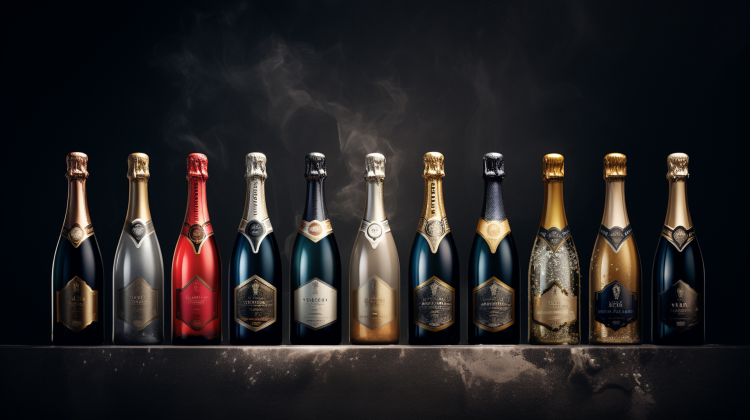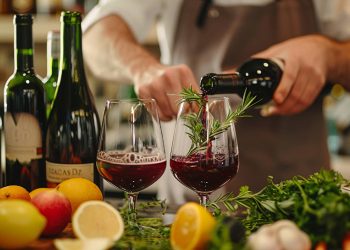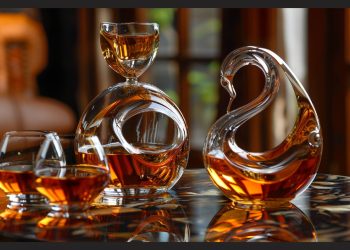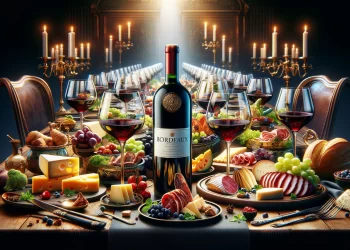Champagne, renowned for its elegance and association with special occasions, offers a range of bottle sizes that enhance the experience for enthusiasts. From petite Piccolo bottles to colossal Melchizedek bottles, each size has its own allure. In this article, we will explore the history, features, and rarity of champagne bottle sizes. We will also discuss the importance of proper chilling, opening, and storing techniques. By understanding champagne bottle sizes, you can elevate your appreciation of this effervescent delight during any celebration or indulgent moment.
Understanding Small Champagne Bottles
The understanding of small champagne bottles is essential for those seeking to explore the variety of sizes available in the market. Small champagne bottles, also known as mini champagne bottles (you can find more of them on here) , come in different sizes that cater to different occasions and preferences. The most common small bottle size is the piccolo bottle, which holds 187.5 mL of champagne. This petite bottle has an Italian origin, with “piccolo” meaning small. Another small champagne bottle size is the demi bottle or fillete, which holds 375 mL and is half the size of a standard bottle.
By understanding these small bottle sizes, enthusiasts can make informed decisions when selecting the perfect bottle for their celebrations. This article section aims to provide a comprehensive understanding of the various champagne bottle sizes available in the market.
Exploring Standard Champagne Bottles
Exploration of the dimensions of standard bottles reveals their ubiquity in the world of celebratory beverages. Standard bottles, also known as “750 mL” bottles, are the most common size and hold approximately 6 flute glasses or 4 tulip glasses. They are equivalent to 2 magnum bottles. To provide a visual representation of champagne bottle sizes, here is a table:
| Champagne Bottle Size | Volume (mL) | Equivalent to |
|---|---|---|
| Standard | 750 mL | 6 flute glasses, 2 magnum bottles |
| Magnum | 1.5 L | 2 standard bottles |
| Jeroboam | 3 L | 4 standard bottles |
| Methuselah | 6 L | 8 standard bottles |
These standard bottles are perfect for celebrating and impressing, and they are widely available in the market. Their size and volume make them suitable for sharing among a small group of people.
Decoding Large Champagne Bottles
Deciphering the dimensions of large bottles provides insight into the grandeur and variety available in the world of celebratory beverages. When it comes to decoding large champagne bottles, here are three key sizes to consider:
- Magnum bottle (1.5 L): This size is equivalent to two standard bottles and holds 1.5 liters of champagne. It is perfect for celebrating and impressing, with a wide range of magnum gifts available.
- Jeroboam bottle (3 L): Also known as “Jero,” this size is double the size of a magnum bottle, holding 3 liters of champagne. It offers four times the amount of a standard bottle and personalized Jeroboam bottles are available for purchase.
- Methuselah bottle (6 L): Equivalent to 8 standard bottles, the Methuselah bottle holds 6 liters of champagne. It serves about 48 glasses and weighs 12kg, providing a showstopping Champagne experience.
These large bottle sizes allow for a truly memorable and extravagant celebration.
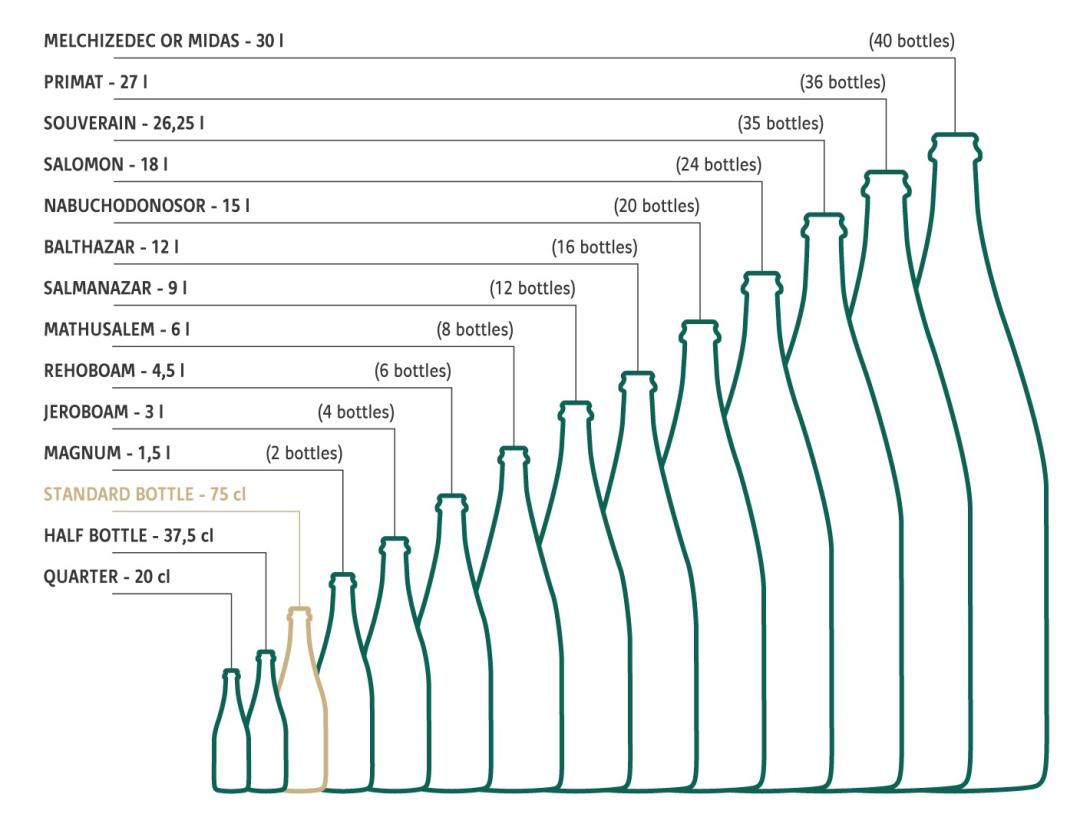
The Mystery of Extra Large Bottles
Unveiling the secrets behind the colossal champagne bottles, the realm of extra-large bottles holds an air of intrigue and fascination. These extraordinary bottle sizes, such as the Balthazar (12 L), Nebuchadnezzar (15 L), Solomon (18 L), Sovereign (25 L), and Primat (27 L), captivate the imagination of champagne enthusiasts.
These bottles are not only larger in size but also symbolize grandeur and celebration. They are often reserved for special occasions, where the presence of such a magnificent bottle heightens the sense of excitement and camaraderie. The sheer size and rarity of these extra-large bottles make them highly sought after and cherished by collectors and connoisseurs alike. They represent the pinnacle of champagne craftsmanship and the epitome of luxury, creating a sense of belonging and exclusivity for those fortunate enough to experience them.
Champagne Bottles: History and Shapes
Continuing the exploration of champagne bottle sizes, the next aspect to delve into is the history and shapes of these iconic vessels. Here are three key points to consider:
- Evolution of Champagne Bottles: Champagne bottles have a rich history dating back to ancient times. Initially, wine was stored in wooden casks and clay amphorae. However, the use of glass bottles for wine storage became prevalent in the 17th century. Over time, bottles evolved to accommodate the unique characteristics of sparkling wine, such as carbonation.
- Round and Heavy Shapes: Champagne bottles are typically round and heavy due to the pressure created by the carbonation process. This shape helps to contain the bubbles and maintain the quality of the wine. Additionally, bottles are commonly made in shades of olive green, which helps to protect the wine from UV light.
- Variations in Shapes: While round is the predominant shape for champagne bottles, there are also variations in body shapes, although they are relatively rare. Square, rectangular, and other unconventional shapes exist, but they are not as common as the traditional round bottles. These variations in shape add a touch of uniqueness and artistry to the world of champagne.
Understanding the history and shapes of champagne bottles adds depth and appreciation to the experience of enjoying this exquisite beverage.
The Art of Opening Champagne Bottles
After exploring the intricacies of champagne bottle sizes, the next aspect to examine is the delicate art of opening these effervescent treasures. Opening a bottle of champagne requires finesse and precision to ensure a safe and enjoyable experience. To open a champagne bottle, start by chilling it to about 45 degrees Fahrenheit to reduce pressure and prevent the cork from flying. Remove the foil and loosen the cage by twisting it counterclockwise. Hold the bottle at a 45-degree angle, away from guests, and gently twist the bottle, not the cork, until it releases with a hiss or gentle pop.
It is important to maintain control and avoid unnecessary force to prevent spills and accidents. Mastering the art of opening champagne bottles adds to the overall enjoyment and celebration of this sparkling beverage.
Preserving Open Champagne Bottles
To ensure that the enthusiasm and flavors of an open bottle of champagne are preserved, proper storage techniques must be employed. Here are three key techniques for preserving open champagne bottles:
- Seal it with a champagne stopper: When you’re not ready to finish the bottle, use an affordable champagne stopper to keep the bubbles intact and prevent leaks. The original cork won’t fit back in, so a stopper is essential.
- Store it in the refrigerator: Champagne should be stored in the refrigerator to maintain its freshness. Keeping it chilled helps preserve the bubbles and flavors. Aim for a temperature of 45 degrees Fahrenheit.
- Use the right glassware: If you plan to consume the champagne quickly, you can use regular white wine glasses instead of flutes. However, if you want to preserve the bubbles for a longer period, it’s best to use flutes.
If you wonder about wine bottle sizes, you have another article for you: Wine Bottle Sizes

